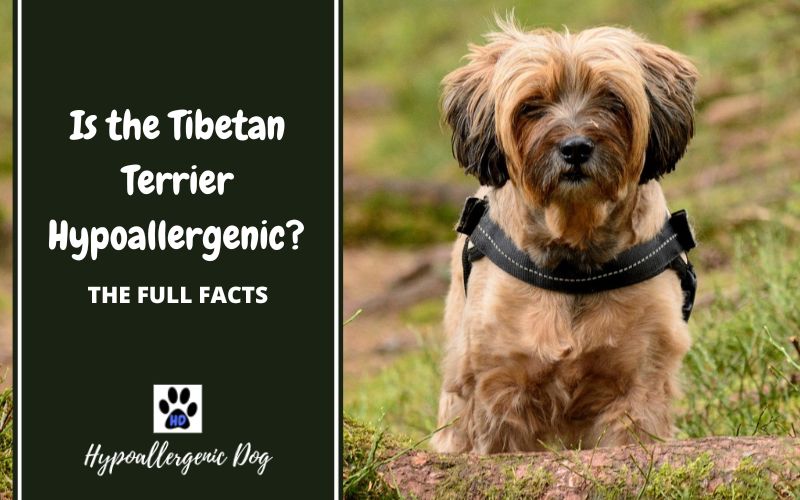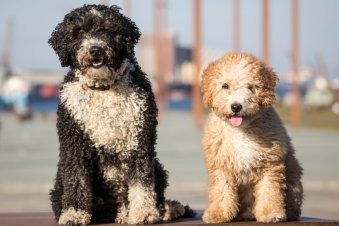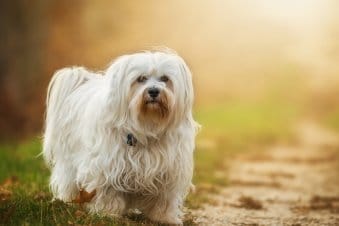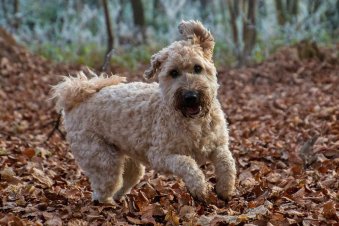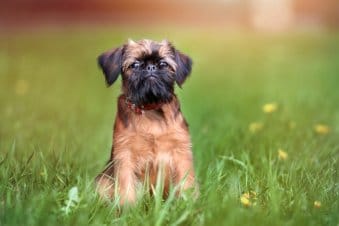Are Tibetan Terriers Hypoallergenic?
Yes! The Tibetan Terrier is a small to medium hypoallergenic dog breed that hardly sheds or drools.
The Tibetan Terrier, sometimes called the “TT”, was bred in Tibet and highly valued by Buddhist Monks. They were not to be sold, but rather, given to monks as gifts. These dogs were praised for their loyalty, their companionship, and their vigilant nature which they used to alert their Monk masters of any perceived threats.
Despite their name, Tibetan Terriers are not actually Terriers. Terriers are hunting dogs that are usually small and are often used to hunt small game like otters, or to kill rats and other vermin. TT’s, however, were often used to herd, or as watch dogs.
Tibetan Terriers are hypoallergenic double-coated dogs that shed lightly and seasonally.
For a quick summary of the Tibetan Terrier skip to our Tibetan Terrier dog breed summary further down the page.
Click here to view more hypoallergenic dog breeds.
Are Tibetan Terriers Hypoallergenic Dogs? Contents
Tibetan Terrier Quick Facts
About the Tibetan Terrier Breed
Tibetan Terrier Training and Exercise
Tibetan Terrier Grooming and Care
Tibetan Terrier Health Issues and Care
Conclusion
Tibetan Terrier FAQ
Tibetan Terrier Facts Summary
Tibetan Terrier Quick Facts
| Hypoallergenic Dog: | Yes! |
| Shedding: | Low shedding |
| Drooling: | Low |
| Size: | Small –Medium |
| Breed Group: | Working |
| Lifespan: | 12-15 years |
| Energy Level: | High |
| Trainability: | Medium |
| Family Dog: | Yes! |
About the Tibetan Terrier Breed

The Tibetan Terrier Physical Characteristics and Coat
Tibetan Terriers have a long double-coat with a rugged, wavy topcoat and a wooly, softer undercoat. They come in black, gold, brindle, white, and sable. Often, their coats will have two to three colors, usually with white or gold being the secondary color. Gold is the rarest of the colors.
Their protective outer coat has a natural, rough appearance. Their heads are broad, and their eyes are widely spaced. When their coats are grown out, they often look very similar to a Bearded Collie. The build of the Tibetan Terrier is muscular and square. They have unique and distinctive feet, which are flat and similar to snowshoes. Their strange feet helped them to navigate the snowy, mountainous terrain of Tibet.
Tibetan Terrier Temperament
Despite the fact that they are not terriers, these dogs can still be quite a handful. They are extremely energetic, upbeat, and cheerful, but they’re also clever at breaking the rules and they can be stubborn, as well as destructive. They definitely are not a breed for the laid-back sort.
Some Tibetan Terriers are described as shy, aloof, or quiet, but that is uncommon. Most of these dogs will be quite friendly and sociable if they have ample opportunities to socialize when they are young. The breed is known for its watch dog tendencies and will readily bark at suspicious noises or intruders. However, they are certainly not to be mistaken for attack dogs, as they are not aggressive by nature and are unlikely to defend the homestead.
Are you considering adopting a Tibetan Terrier?
- Tibetan Terriers need a ton of grooming! Their long coats can easily become matted, which can be uncomfortable for them and may require you to cut out big chunks of their hair if you don’t keep up with their grooming. Their raggedy coats gets dirty very quickly.
- Tibetan Terriers are generally great with kids! However, they are herding dogs, so they have an instinct to nip. Therefore, it’s best to monitor them with kids that are younger than five or six, or are afraid of, or inexperienced with dogs.
- Tibetan Terriers are terrible dogs to leave alone. They can’t stand being away from their people and they can get very destructive if left in the house uncrated for too long.
- These guys have a surplus of energy! They are excellent for doggy sports or as jogging partners, but they are not great pets for people who aren’t very active.
Tibetan Terrier Training and Exercise
Encouraging Good Behavior In Your Tibetan Terrier
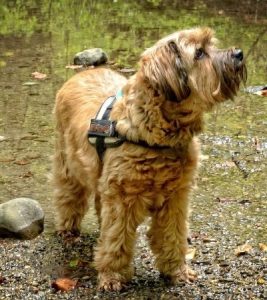
It is very difficult to train Tibetan Terriers, due to their stubborn nature. Owners that have had previous experience with dogs, will have a better chance at interpreting this herding dog’s “What’s in it for me” attitude.
Having a well-trained member of the breed requires constant vigilance from day one. Reinforcement should be firm, but fair, as these dogs are sensitive and intelligent, so they may lose respect for a forceful or angry owner. Crate training is essential for Tibetan Terriers, because they can suffer separation anxiety, which can make them a danger to themselves, and your home, if you leave them unattended. These dogs are very people-orientated, though, and should not be left alone for too long. Four hours is generally as long as you would want to leave them in a crate without human contact. Remember that Tibetan Terriers are NOT outside dogs. Even though they’re very weather resistant, constant human companionship is essential for them.
Tibetan Terrier Exercise Needs
Tibetan Terriers need quite a bit of exercise to curb their energetic, riotous side. A young TT at a healthy weight who is under-exercised is likely to become a destructive maniac. They are best suited to people that have an active lifestyle and a household with multiple people. Your TT will need a minimum of a 40 minute walk, or two 20 minute walks as day. Tibetans love to run. Unfortunately, but many times, they can’t be trusted to come back to you after they’re let off the leash. It’s best to give your Tibetan Terrier ample amounts of free time outside in a securely fenced in area. Backyards and dog parks are great options.
Due to their intelligence and their abundance of energy, these dogs are excellent candidates for dog sports. Though they may be challenging to train, sports such as agility and flyball are greeted with great enthusiasm by Tibetan Terriers, so long as you keep a positive, upbeat attitude. Training your dog for sports like these is a great way to challenge their minds, lessen their destructive tendencies, and inspire respect, obedience, and loyalty!
Tibetan Terrier Grooming and Care

Maintaining Your Tibetan Terrier’s Coat
This hypoallergenic, medium-sized dog has an endearingly shaggy outer coat that usually catches the hair that is shed from their softer undercoat. Their course topcoat is very good at collecting dirt, debris, and all manner of unpleasant things – so you will either have to brush them daily, and bathe them frequently, or keep their coats clipped short. The “puppy cut” is a popular short-haired trim, but it removes the topcoat so it causes most Tibetan Terriers to visibly shed on clothing or furniture.
As far as shedding is concerned, TT’s do have a tendency to shed more during certain seasons. This is particularly noticeable if you keep them in a puppy cut. At around 9 months of age, a puppy will shed a good deal of its coat, so you should groom them vigilantly during this time.
Teeth, Ears and Nails
In addition to keeping their coat in check, you will need to keep up with some other aspects of your TT’s hygiene. When grooming the coat, check the ears for odor or discoloration. You can clean out their ears once a week with a solution that is half water and half white distilled vinegar. Moisten a cotton ball, and gently wipe dirt and debris out of the ear canal. Be sure never to use q-tips when cleaning out a dog’s ears, as they can cause harm.
Teeth should be brushed weekly, even if you provide dental cleaning treats. These treats are excellent at keeping a dog’s front teeth clean, but they are rarely suitable for the back teeth, which is where a lot of problems occur in your dog’s older years. As dental hygiene is very important, you should brush your puppy’s teeth often when they are young (even if they don’t need it), just to get them used to the sensation.
Some active dogs do not need their nails trimmed as much as others. Check the length of your Tibetan Terrier’s nails about once every two weeks and trim them if they are getting too long. All dogs have a living part to their nail, called the “quick”, that bleeds if you cut the nail too short. However, if you start trimming your dog’s nails when they are a puppy, and keep up their short nail length, their quicks won’t grow very long.
Tibetan Terrier Health
Tibetan Terrier Health Issues and Care

These robust little dogs are quite hearty, with very few health problems. Obesity greatly increases their risk of developing hip dysplasia or hypothyroidism, so it is important to make sure your Tibetan Terrier gets plenty of exercise, access to water, and eats a good quality dog food. To avoid other health issues, get your dog from a good breeder. Good breeders screen the dogs they are breeding for genetic health problems or other defects that could affect the welfare of the puppies.
Here is how to check for a good Tibetan Terrier breeder :
Before you meet the breeder:
- Ask to see results that show that the parent dogs have passed the following tests and examinations :
- Neuronal Ceroid Lipofuscinosis (N.C.L.)
- Primary Lens Luxation (P.L.L.)
- Hip Evaluation, and
- Ophthalmologist Evaluation
- Ask the breeder how many litters they have in a year, how old the dam (mother) is,
and if there were any complications with her past litters. Breeders that breed too many
different types of dogs, have many litters a year, and have a dam that is older than 6
years of age are suspicious and may even be sources for puppy mills. - Ask the breeder how expensive the puppies are. Most well-bred, purebred dogs are over $1,000. Be suspicious of puppies that are too inexpensive. Breeding dogs is very expensive in and of itself, and it requires a lot of time and energy. If the puppies are inexpensive, than the breeder is likely doing something to make up for the loss of the extra income.
When you visit:
- Ask to see the dam. She should be happy, friendly, clean, and alert. Most likely, she will be with, or near her puppies.
- Ask to see where the puppies sleep. This area should be clean and safe. If puppies
are training with potty pads, there may be some mess on the pads, but the floor of the
enclosure should not be covered with urine, feces, or dirt. - Ask how the puppies are handled and whether they are allowed outside or in the house. Ideally, breeders will handle the puppies daily and allow them inside the house to explore and socialize with other family members. Many breeders expose their puppies to the outdoors, so they can get used to it. They may even encourage puppies to make some progress potty-training.
- Ask to see pedigree papers for both the sire (father), and the dam.
Food for thought:
- Does your breeder seem overly cautious about your home environment or your experience with dogs?
- Do they seem somewhat fixated on papers and contracts?
- Are they advocates for the health and well-being of their puppies for the duration of the puppy’s life?
- Are they interested in the breed, and happy to tell you about the temperaments and the health concerns of Tibetan Terriers, and what sort of lifestyle is best suited for their dogs?
Don’t be annoyed – that is what good breeders do!
Common Health Issues for Tibetan Terriers
Hip Dysplasia
Cataracts
Distichiasis
Hypothyroidism
Lens Luxation
Patellar Luxation
Progressive Renal Atrophy (PRA)
Conclusion
Tibetan Terriers are lively pets! They’re generally great with kids, but they should be monitored with young kids. These guys don’t shed very much because the hairs that are shed by their undercoat get stuck in their rough overcoat. While they are hypoallergenic, and aren’t known to be drooly, they are notorious for being able to get very dirty, very quickly! You have to set aside quite a bit of time if you’re wanting to own a Tibetan Terrier just to maintain their coat. They need to be brushed almost daily to avoid their hair matting. For those that don’t have the time, a “puppy cut” is a type of coat trim that will keep their hair shorter, but it also increases shedding. TT’s can be pretty independent. Don’t expect immediate or consistent obedience. This dog is more likely to see you as a partner or an equal than idolize you. Despite that, they are extremely loving, loyal, and affection pets! If that’s not enough, they make excellent watch dogs as well!
Tibetan Terrier FAQ
Do Tibetan Terriers Shed?
If you don’t trim their coat, they don’t usually shed much. They may shed a bit seasonally. However, if you trim their coat short enough to expose their undercoat, they will shed a lot more. They also shed a good deal at around 9 months of age, but they will grow out of it.
Are Tibetan Terriers good pets?
They can be if you :
Live in an active household, have children that are old enough to go to school, work at home or are able to provide dog sitting services for them, have a fenced in backyard, and have the time or the budget to groom and clean them regularly.
They’re not if you :
Work 9-5 and need to leave your dog alone at home all day, don’t exercise much or prefer to exercise at the gym rather than walking with, or playing with your dog, live in a small apartment with no backyard, or are going to college.
What are some personality traits of a Tibetan Terrier?
Exceptionally friendly and playful – they have intelligent, thoughtful eyes…if you’re able to see them through all that hair! Tibetan Terriers are goofy, mischievous, and independently minded – they may not immediately respond to commands. They love being with their people above all else, and they are alert to any strange sounds or possible intruders. However, they’re not aggressive dogs, just good watch dogs.
Are Tibetan Terriers good family dogs?
Tibetan Terriers can be excellent family dogs! They are extremely friendly and playful. They do, however, have a tendency to nip and should not necessarily be trusted around children under 5.
Is the Tibetan Terrier double coated?
Yes. They have a rough, shaggy, wavy topcoat with a soft, wooly coat underneath.
What is the cost of a Tibetan terrier?
$1,200 – $2,000, if you’re getting them from a good breeder.
Are Tibetan Terriers easy to train?
They are moderately challenging. They are very independent and often don’t respond to commands.
Are Tibetan Terrier good swimmers?
No, Tibetan Terriers are known to dislike swimming.
What is the average life expectancy of a Tibetan terrier?
About 12-15 years, however, a dog who is a healthy weight and fed good quality food, given access to clean water, and exercised regularly usually lives longer than average.
Are Tibetan Terriers fussy eaters?
Yes, Tibetan Terriers can often be picky eaters.
Is the Tibetan Terrier intelligent?
Yes, but they are not necessarily obedient.
Tibetan Terrier Facts Summary
| Breed | Tibetan Terrier |
| Other Names? | Tsang Apso, Dokhi Apso |
| Hypoallergenic? | Yes |
| Height | 14″ – 17″ (35.5 cm – 43 cm) |
| Weight | 18 lbs – 31 lbs (8 kg – 14 kg) |
| Lifespan | 12-15 years |
| Temperament | Affectionate, Playful, Energetic, Amiable, Gentle, Sensitive, Clever, Funny |
| Colours | White, Black, Brindle, Piebald, Tri-color, Golden |
| Coat – describe the coat | Double-coated with a rough, shaggy, wavy outer coat and a soft wooly undercoat. |
| How much grooming? | A lot – daily, and frequent baths. |
| How much shedding | Light shedding seasonally, but they go through a stage at 9 months of age where they shed a lot. They shed more when their coat is shaved. |
| Dander levels | Low dander level |
| Saliva – Do they Drool or Lick much? | Low |
| Energy levels | High |
| How much exercise do they need? | 40 minute walk daily |
| Health problems | canine hip dysplasia (CHD), cataracts, distichiasis, hypothyroidism, lens luxation, patellar luxation and progressive retinal atrophy (PRA) |
| Good for apartment? | No |
| Suitable for kids? | Excellent with kids, but they can be nippy |
| How much do they bark? | Moderately |
| Can they be left alone? | They are horrible dogs to leave alone. They’re extremely people-orientated and will suffer separation anxiety. |
| Intelligent? | Yes |
| Trainable? | Moderately so, they are very independent and willful |
| How popular as a pet? | Rare. Ranks 91 of 194 |
| Any other important facts? | Tibetan Terriers are not actually terriers. They are closer to livestock guardians and herders. They are called terriers because dog breeds of this size were generally classified as terriers when they were brought over to England. |

